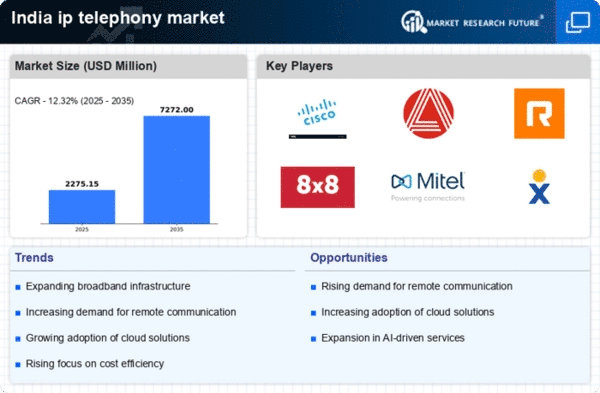Growing Internet Penetration
The rapid increase in internet penetration across India is a crucial factor driving the ip telephony market.. As of November 2025, approximately 700 million individuals in India have access to the internet, representing a penetration rate of around 50%. This widespread connectivity facilitates the adoption of internet-based communication solutions, making ip telephony more accessible to businesses and consumers alike. The growing number of internet users is likely to enhance the demand for cost-effective communication solutions, as organizations seek to leverage the benefits of VoIP technology. Furthermore, the expansion of broadband infrastructure, particularly in rural areas, is expected to contribute to the growth of the ip telephony market, enabling more users to transition from traditional telephony to internet-based services.
Cost Efficiency of VoIP Solutions
The cost efficiency associated with VoIP solutions is a significant driver for the ip telephony market in India. Businesses are increasingly recognizing the financial advantages of switching from traditional telephony systems to ip-based communication. VoIP services can reduce communication costs by up to 50%, particularly for long-distance calls. This reduction in expenses is particularly appealing to small and medium-sized enterprises (SMEs) that are looking to optimize their operational costs. Additionally, the ability to integrate various communication tools into a single platform further enhances the value proposition of ip telephony solutions. As organizations continue to prioritize cost management, the ip telephony market is likely to experience sustained growth, driven by the demand for affordable and efficient communication alternatives.
Shift Towards Remote Work Culture
The shift towards a remote work culture is greatly impacting the ip telephony market in India.. As organizations increasingly adopt flexible work arrangements, the demand for reliable and efficient communication tools has surged. The need for seamless collaboration among remote teams has led to a greater reliance on ip telephony solutions, which offer features such as video conferencing, instant messaging, and team collaboration tools. This trend is particularly pronounced among tech-savvy companies that prioritize digital communication. As remote work becomes a permanent fixture in many organizations, the ip telephony market is likely to experience sustained growth, driven by the need for effective communication solutions that support a distributed workforce.
Technological Advancements in Communication
Technological advancements play a crucial role in shaping the ip telephony market in India. Innovations such as artificial intelligence (AI), machine learning, and advanced analytics are being integrated into ip telephony solutions, enhancing their functionality and user experience. For instance, AI-driven features like automated call routing and virtual assistants are becoming increasingly common, improving efficiency and customer satisfaction. Moreover, the introduction of 5G technology is expected to further bolster the ip telephony market by providing faster and more reliable internet connections. As these technologies continue to evolve, they are likely to drive the adoption of ip telephony solutions, enabling businesses to leverage cutting-edge communication tools that enhance productivity and collaboration.
Regulatory Support for Digital Communication
Regulatory support for digital communication is emerging as a key driver for the ip telephony market in India. The government has been actively promoting digital initiatives, such as the Digital India campaign, which aims to enhance the country's digital infrastructure and encourage the adoption of internet-based services. This supportive regulatory environment is likely to foster innovation and investment in the ip telephony market, as companies seek to align their offerings with government initiatives. Furthermore, the establishment of clear guidelines and standards for VoIP services can enhance consumer confidence, encouraging more businesses to transition to ip-based communication solutions. As regulatory frameworks continue to evolve, they are expected to play a vital role in shaping the future of the ip telephony market.
















Leave a Comment